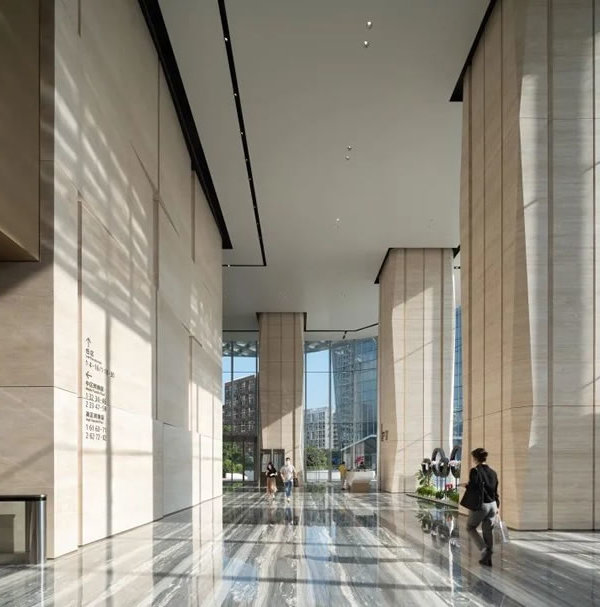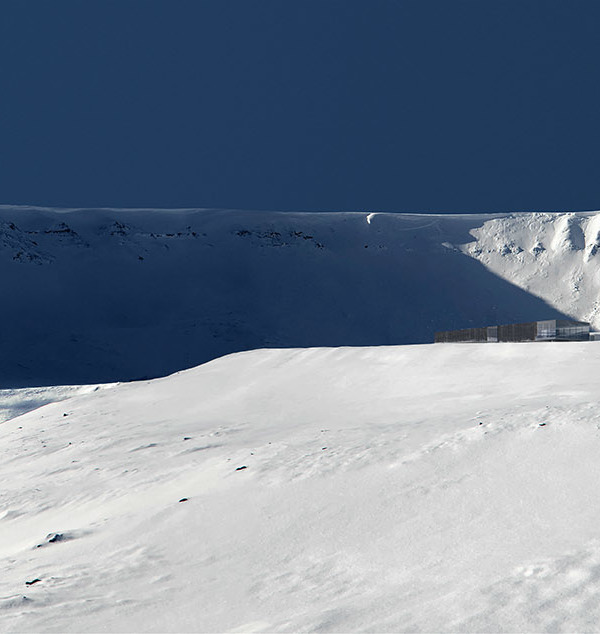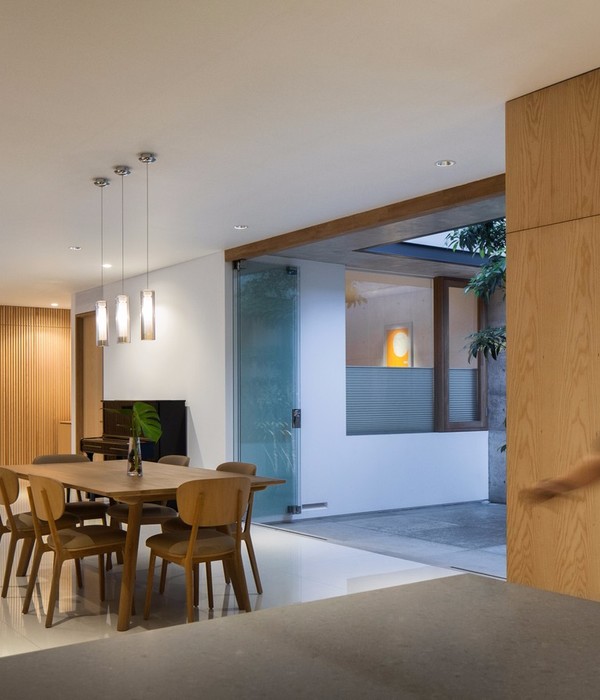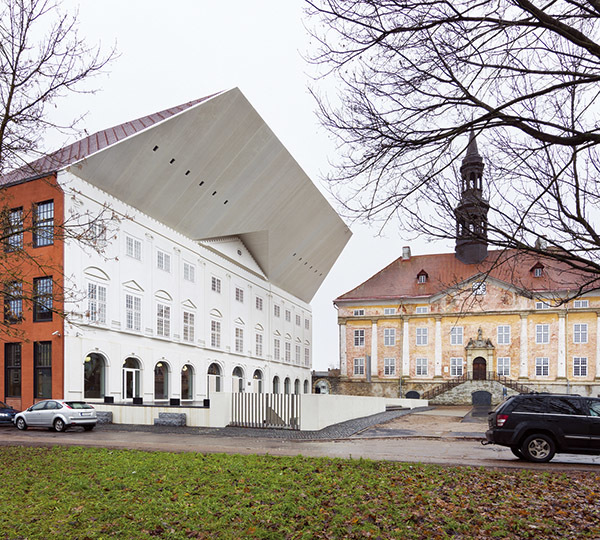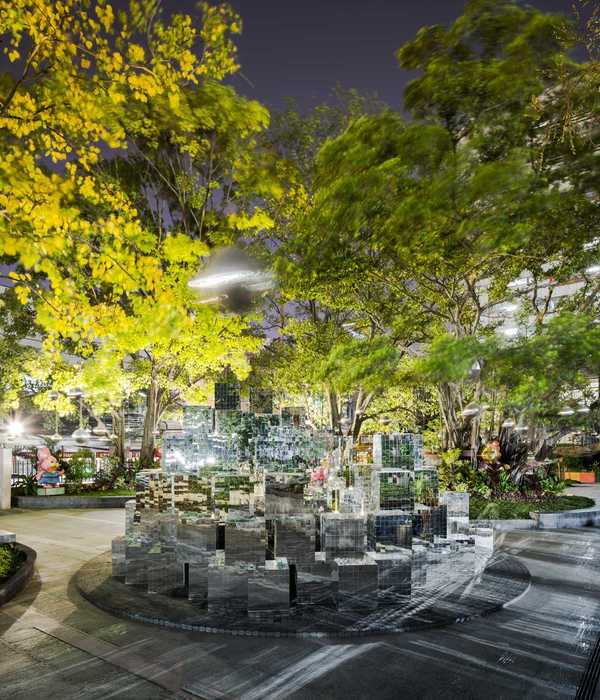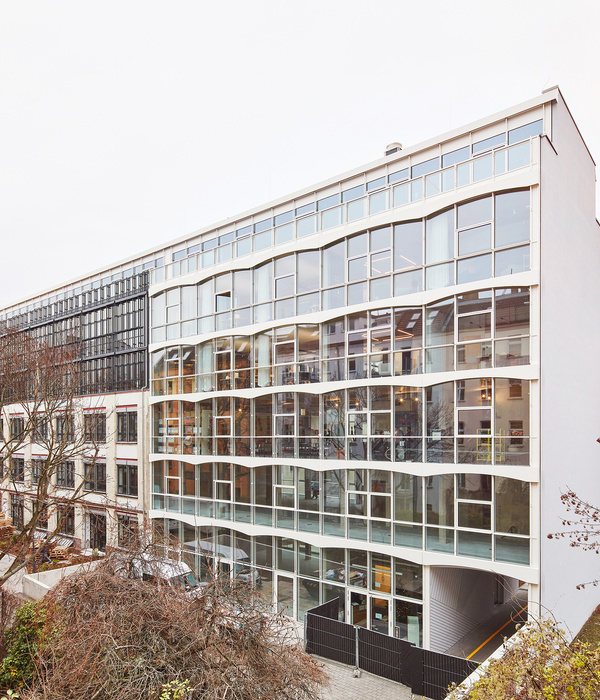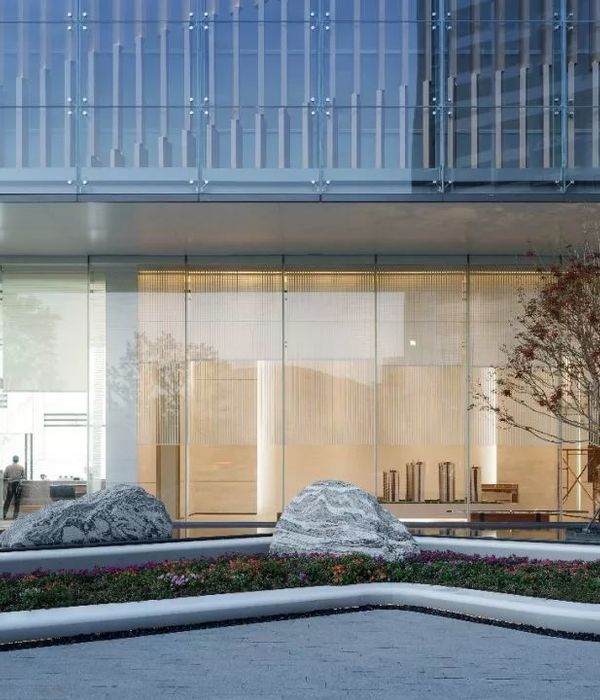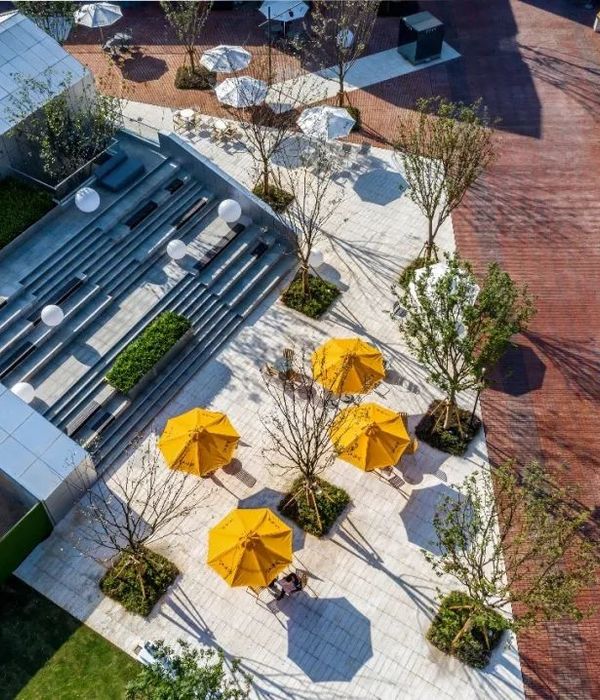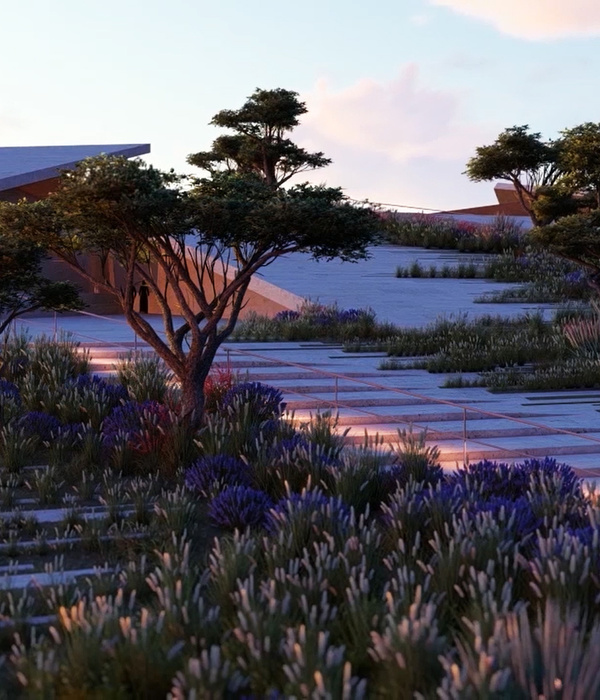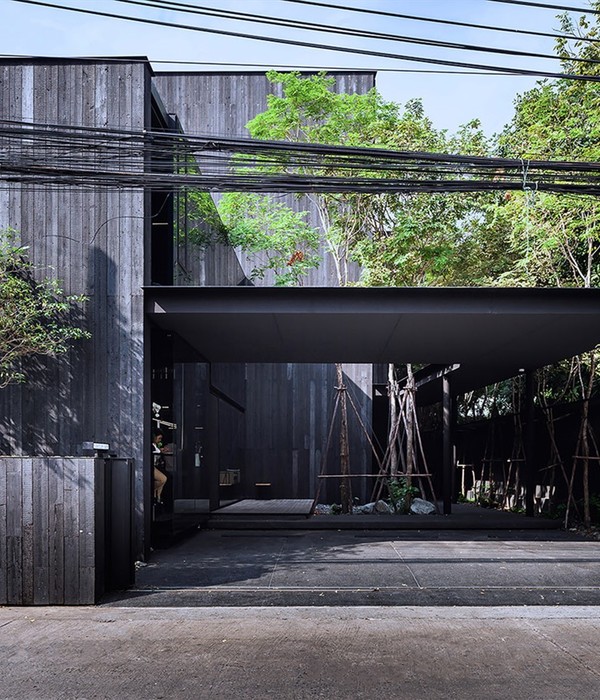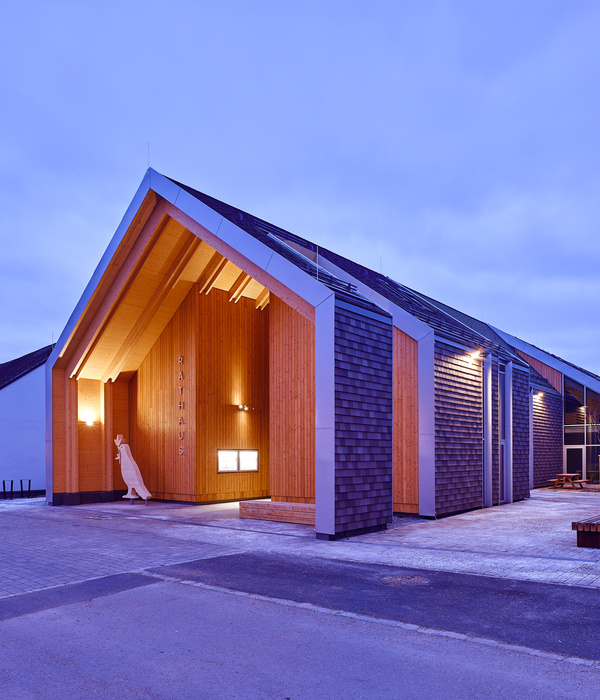© James Dow
(C)詹姆斯·陶氏
架构师提供的文本描述。黄大仙寺是一个现代的神圣空间,是一个充满活力的道教团体,通过太极的古老物理实践,致力于他们内在的精神发展。位于多伦多郊区的凤洛伊角道教学院需要一个新的精神家园,不仅要反映他们宗教信仰的精神和灵魂,还要反映他们的信徒们的现代世界。这个礼拜场所位于郊区一条主要的主干道上,周围环绕着一家购物中心和豪华的独栋住宅。
Text description provided by the architects. The Wong Dai Sin Temple is a modern sacred space that houses a dynamic Taoist community committed to their inner spiritual development through the ancient physical practice of tai chi. The Fung Loy Kok Institute of Taoism needed a new spiritual home in suburban Toronto that had to reflect not only the heart and soul of their religious beliefs but also the modern contemporary world of their congregants. This place of worship is located on a major suburban arterial road surrounded by a shopping mall and cul de sac’s lined with oversized single family residential mansions.
© James Dow
(C)詹姆斯·陶氏
这座新的寺庙建筑在保持平衡的同时,表现出不对称和平衡,就像一种有节制的太极姿态。从繁忙的公路向南可以看到建筑物的南立面,在细长的混凝土桥墩上可以看到一个主梁和小悬臂。严格的现场停车要求需要提升地面上的精神空间,并在下面提供地面停车位。这个神圣的空间是由一个双向混凝土板支撑的,它与七个矩形浇筑在一起的混凝土桥墩连接在一个坚固的木筏基础上。
This new temple building demonstrates asymmetry and counterbalance while maintaining its equilibrium much like a measured tai chi pose. The building’s south elevation is visible from the busy roadway to the south, reveals a major and minor cantilever supported on slender concrete piers. Stringent on-site parking requirements necessitated elevating the spiritual space above ground and providing surface parking below. This sacred space is supported on a two-way concrete slab integrated with seven rectangular poured in place structural concrete piers tied to a robust raft foundation.
© James Dow
(C)詹姆斯·陶氏
双向粘结柱张拉混凝土板体系,其悬臂梁位于西部,悬停在停车场之上,作为上述神圣空间的结构支撑。在后张式结构的东侧有一个较小的5.2米悬臂,在下面的停车处设有一个外部露台,并可作为西侧较长悬臂的反平衡。在东北和东南部的两个悬臂楼梯上,也使用外露混凝土,该楼梯与电梯一道,为进入二楼的礼拜空间提供了通道。
The two-way bonded post tensioned concrete slab system with its 10.2m cantilever on the west hovers over the parking area which acts as the structural support for the sacred space above. A smaller 5.2 m cantilever on the east side of the post tensioned structure accommodates an exterior terrace over the parking below and serves as a counter balance for the longer cantilever to the west. Exposed concrete is also used for the two cantilevered staircases, on the north east and south east, which along with an elevator, provides access to the second floor worship space.
© James Dow
(C)詹姆斯·陶氏
这座建筑的北面和南面的外观都是由形状的风化钢垂直鳍组成的,用来控制从内向外的视野。在祈祷空间的大垂直地板到天花板窗口开口向外伸展,确保周边的自然光和良好的交叉通风。西面和东面的高地上都覆盖着大型的、由风化钢制成的抽象面板,确保了隐私。
The building’s exterior on the north and south facades is clad in shaped weathering steel vertical fins that are used to control views from the inside looking out. Large vertical floor to ceiling window openings in the prayer space splay outward ensuring both natural light at the perimeter and good cross ventilation. The west and east elevations facing the neighbours are clad in large abstract panels of weathering steel ensuring privacy.
在黄大仙寺内,大型圆形机动天窗与大型红灯显示器相连,确定了进入空间的自然光,并为用于道教诵经和祈祷仪式的大香环提供了支撑。这些不同直径的发光红灯笼创造了一个宇宙天花板计划,并提供了虚幻的自然光,它与燃烧的熏香混合在一起,创造了一个连接天空和地面的精神空间,并将我们的内在自我与外部世界连接起来。
Inside the Wong Dai Sin Temple, large circular motorized skylights are linked to large red light monitors which defines the natural light entering the space and also provides supports for large rings of incense used for Taoist chanting and prayer ceremonies. These glowing red lanterns of varying diameters create a cosmic ceiling plan and provide ethereal natural light which co-mingles with burning incense creating a spiritual space linking sky and ground and connecting our interior self with the external world beyond.
© James Dow
(C)詹姆斯·陶氏
在祈祷大厅内是黄大仙寺内最内向的空间,这是它的纪念馆。寺庙内的这座小木屋是一个沉思的空间,祖先在那里受到尊敬。竹牌匾线的内部木屋提供了一个私人沉思的场所。会众有机会留下感恩的祭品,点燃香,以纪念他们的爱人。
Within the prayer hall is the most introverted space in the Wong Dai Sin Temple which is its memorial hall. This small wooden building within the temple is a contemplative space where ancestors are honoured. Bamboo memorial plaques line this internal wooden room providing a place for private contemplation. There are opportunities for congregants to leave offerings of gratitude and to light incense in honor of their love ones.
© James Dow
(C)詹姆斯·陶氏
这个空间与世界其他地方的其他古老的黄大仙神殿有着千丝万缕的联系,它通过对自然光的操纵和放大,它对色彩的器质性使用,以及它对精心制作和触觉的材料调色板的承诺。世界上最古老的道教宗教之一的日常崇拜就植根于这一现代神圣空间的结构之中。
This space is inextricably tied to other ancient Wong Dai Sin Temples in other parts of the world through its manipulation and amplification of natural light, its instrumental use of colour and its commitment to a carefully composed and tactile material palette. The daily worship of one of the world's ancient religion of Taoism is embedded in the fabric of this modern sacred space.
© James Dow
(C)詹姆斯·陶氏
Architects Shim-Sutcliffe Architects
Location Markham, ON, Canada
Lead Architects Brigitte Shim, Howard Sutcliffe
Project Leads Monica Leung, Andrew Kimber
Area 3271.0 ft2
Project Year 2015
Photographs James Dow
Category Temple
{{item.text_origin}}


